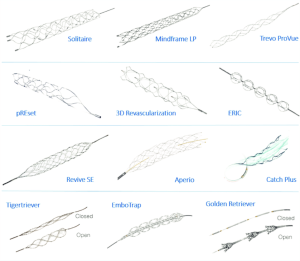In a scoping review Song et al.from: – Austin Health, Melbourne (Radiology) – St Vincent’s Health, Melbourne (Interventional Neuroradiology) – Monash Health, Melbourne (Neurosurgery & Imaging) – Eastern Health/MU, Melbourne – Northern Health/Univ. of Melbourne, Melbourne – SAHMRI, Adelaide – Deakin Univ., Geelong published in the Journal of Clinical Neuroscience with the purpose to map the landscape of stent retriever devices used in mechanical thrombectomy for acute ischemic stroke, stratified by device type and occlusion location. They concluded that Solitaire and Trevo dominate clinical use (~57 % of cases), primarily in M1 and ICA occlusions. Many devices remain under‑studied, especially in distal (ACA, M3+) occlusions. There is a notable evidence gap for newer stent retrievers in medium/distal vessel territory 1).
This review, while comprehensive in device enumeration, falls short in critical appraisal. By pooling data from 133 heterogeneous studies without quality stratification or bias assessment, it gives an inflated sense of evidence. The emphasis on device frequency—rather than outcomes or head‑to‑head efficacy—renders the conclusions superficial. The assertion of a “strong evidence base” for conventional devices is misleading; no meta‑analysis or performance metrics are provided. The claim that distal occlusions are understudied is unsurprising, but the authors offer no actionable framework or proposals for future targeted trials. The review reads more like a registry report than a scoping synthesis intended to inform practice. Novelty is minimal, relevance limited.

